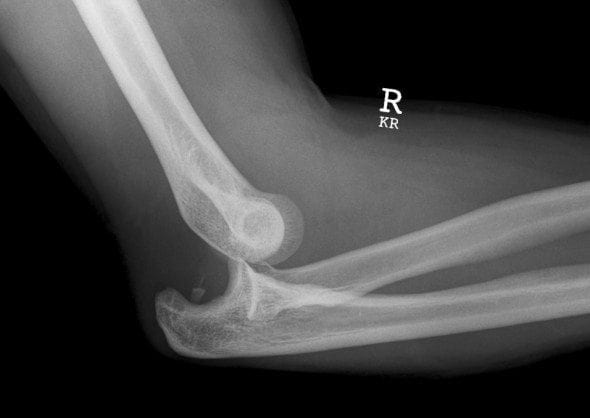Board Review: Oh SNAP!
63 year old male with PMHx of HTN, DM, COPD p/w right elbow pain after falling onto an outstretched hand. Denies head trauma or LOC. On exam, the extremity is held in elbow extension. Radial pulse is 2+ and sensation is intact. There is obvious deformity of the elbow. No further tenderness of the extremity. Xrays demonstrate:


What is the most common fracture associated with this type of dislocation?
A- Supracondylar fracture
B- Radial head and coronoid fractures
C- Distal radius fracture
D- Humeral head fracture
Answer: B- Radial head and coronoid fractures
Elbow dislocations are the third most common type of joint dislocation seen in the Emergency Department. They typically occur after a fall onto an out-stretched hand. Posterolateral dislocations are most common. Anterior, medial, lateral, and divergent dislocations are also possible. Reduction of simple dislocations may be achieved after administering adequate analgesia with opiates or local joint block, however, procedural sedation is often required. Reduction is achieved with traction and countertraction to the joint while applying firm anterior pressure to the posterior olecranon. Splint the patient in a posterior long arm splint with teh elbow in ninety degrees with wrist supination. These patients need urgent follow up with orthopedics within 3-5 days. Complex dislocations include fractures and injury to ligamentous structures. The terrible triad is a posterolateral dislocation with LCL rupture, coronoid fracture, and radial head fracture. These typically require orthopedic consultation for reduction and operative repair.
Bjoernsen, L. P., & Ebinger, A. (2016). Section 22: Injuries to Bone and Joints. In Tintinalli's Emergency Medicine: A Comprehensive Study Guide (8th ed., pp. 1821-1822). New York, NY: McGraw-Hill Education.
Cadogan, M. "Elbow Dislocation." September 2019. <https://litfl.com/elbow-dislocation/.> August 20, 2020.
